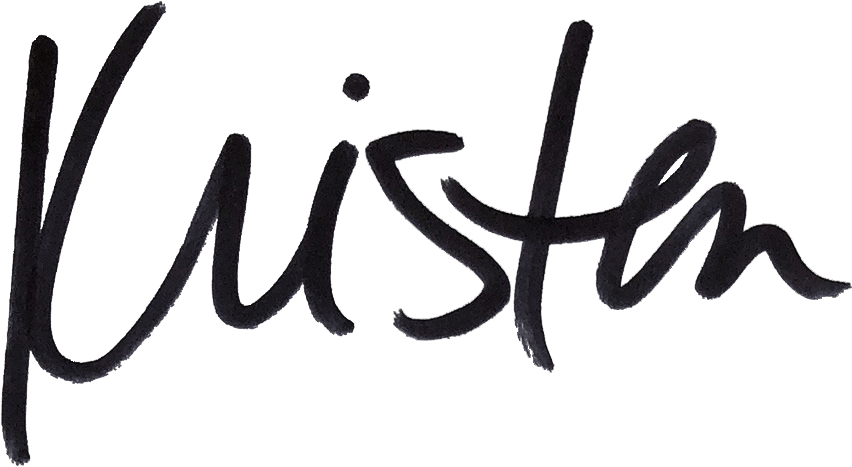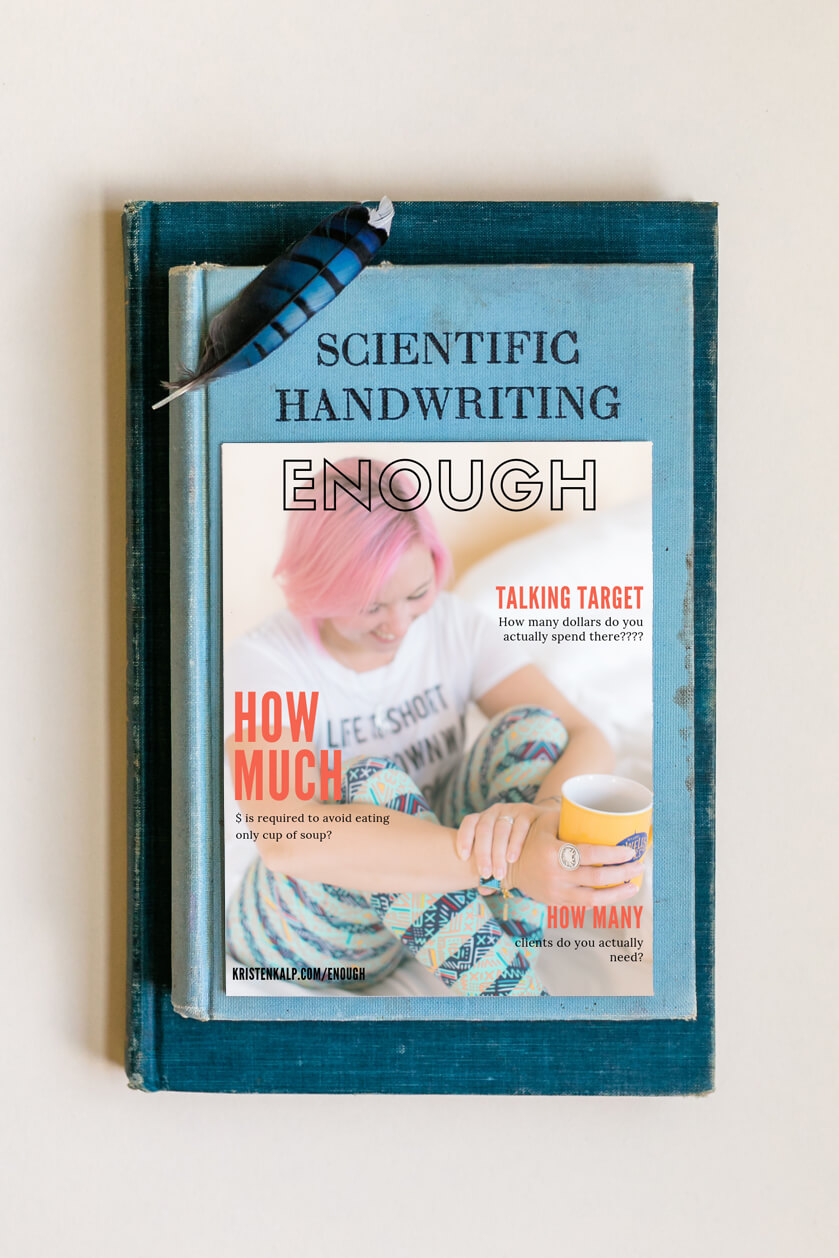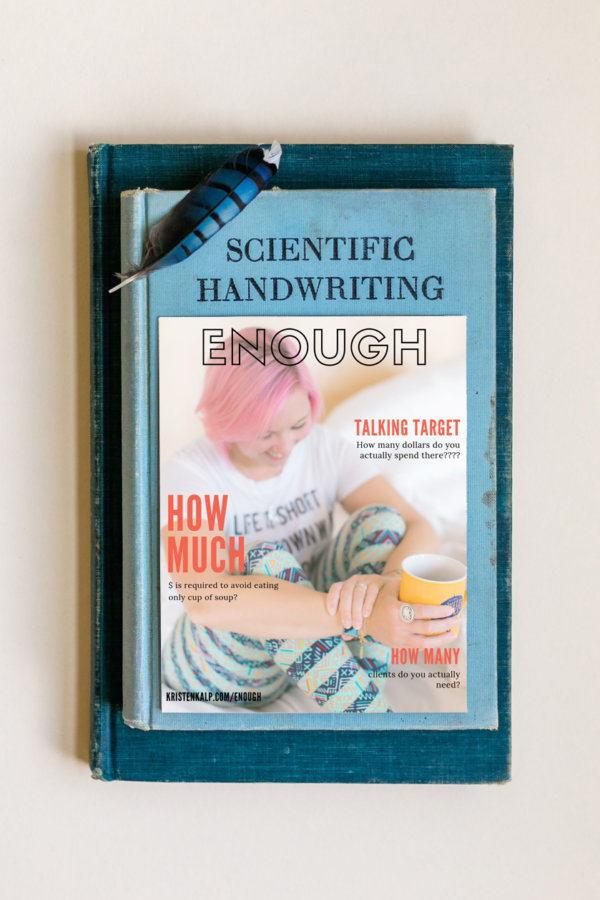Let’s get you started on the road to Actually Talking To Your Peeps On A Regular Basis Without Shame and Fretfulness.
This is an episode of the That’s What She Said podcast! You can tune in below or keep scrolling to get the gist.
For lots of years, I figured someone else knew best about how I should be talking to my peeps about my business. That sounds silly to admit now, but I trusted ‘experts’ to help me navigate the world of business instead of acknowledging that what I was being told frequently felt ‘off,’ wrong, and generally gross.
Mostly I was told to hustle all the time, but be ‘authentic,’ but not too authentic because you need to be professional, but not too professional because then you don’t stand out from the crowd, and ‘put yourself out there’ but NOT LIKE THAT.
I hated hearing from people and businesses only when they were selling something. At the same time, I was worried about how much noise email and marketing and talking about products generated in general, and I didn’t want to contribute to the noise. Which means NATURALLY I ONLY EMAILED MY PEEPS WHEN I WAS SELLING SOMETHING.
Brilliant.
It took 7+ years to realize:
a.) I don’t have to communicate like everyone else communicates
b.) these people WANT to hear from me, and
c.) their responsiveness or lack thereof to any single email in no way indicates how much impact I’m having on their lives.
I’m going to dive deeper into each of these painfully-obvious-but-difficult-to-learn truths in detail, as you enjoy this excerpt from my upcoming class, How to Fucking Communicate.
It’s all about how to actually communicate with the people on your email list instead of failing to create a list, acting as if the list is actually a hive of poisonous and deadly creatures that will kill you upon sending a single email, or truly believing that even though your peeps said they want to hear from you, they don’t actually want to you to email them, because they are lying liars with better ways to spend their time.
You’ve got instant access to the download when you hit the buy button. Read more or pick up your seat now!
Truth #1: You don’t have to communicate like everyone else communicates.
There are people out there who have their creative calendars planned for the next twelve months. They are very willing to share their planners with you on Pinterest or as a free download or in a free seminar or all three. For me, the concept of a ‘creative calendar’ that’s solid and unchanging one year out is utter bullshit.
My creative calendar — which dictates my podcasts, blog posts, and emails — is planned for four weeks out, tops. I know what I’ll be marketing for the next six months (see: how to make a marketing calendar), but what I’ll be writing about, talking about, and generally sharing is always based in my life at the moment of writing, which I can’t possibly anticipate a year in advance.
I’ve been podcasting weekly for over three years now, and blogging for more than nine, and not once have I stuck to an ‘editorial calendar’ or otherwise managed to keep to a strict ‘content’ schedule. I’ve made calendars, absolutely, and scribbled gorgeous plans that are absolutely perfect on paper. And then, within four weeks of starting them, I’m BORED OUT OF MY FUCKING MIND BECAUSE I KNOW WHERE IT’S ALL GOING.
Also, can we stop calling it content? It’s art, and poetry, and emails, and podcasts, and images, and witty commentary, and advice, and useful creativity, and all of the above, and calling it ‘content’ makes us sound like really sad robots pushing out blocks of shiny, commodifiable garbage.
So: you don’t have to communicate like everyone else communicates.
The trick to communicating is consistency.
If you say you’re going to communicate with your peeps once a month, make sure you do. If it’s once a week, or twice a week, or every seventh Tuesday, or on the full moon, or only when the sun sets after 8 p.m….do that. The point is whether you do what you say you’re going to do, not the frequency of your communication.
The length, frequency, and template of your communication is entirely yours.
Again, you’ll see people around you saying you must be SEO-friendly or have more than 300 words or write using words at or below a fourth grade reading level or structure your posts to align with social media, which aligns with Mercury in the House of Gemini and…no.
The length, frequency, and template of your communication is entirely yours.
I’m pushing email specifically because we all have an email account and because Mark Zuckerberg doesn’t own the algorithms that govern it. Any platform in which you can communicate directly with your peeps — such as email, texting, or snail mail — counts as communicating.
Your personal communication cocktail might be:
A stunning image and an inspirational quote with a link to book your work.
A short poem and a testimonial about your work.
Three links to your latest products and a discount code.
Your latest blog post, written out and sent as a standalone email so peeps remember to visit your website.
19 paragraphs from your upcoming novel delivered every Wednesday for a month.
A single podcast episode.
A series of podcasts.
Recent interviews.
A few quick snippets of your life right now and a call to action.
New products, featured products, or sale products.
New services, a featured service, or an update on the availability of a service.
All of the above.
None of the above.
Your communication might benefit from having a template, but it in no way requires you to lock one in for life.
How often do you prefer to communicate?
Which length of email do you prefer to send — short, medium, or loooong?
What do you really want to sell, move, or promote in the next three months?
What do you want to share with your peeps that isn’t about selling, moving, or promoting a product?
When you lock in a timeframe, a length, and a topic or two, communicating is much, much less scary than it was before we began.
I’ll send ______________ every ___________ days. I can talk about __________ or ____________ or ____________, and I’ll be sure to mention __________________, since that’s what pays the bills.
What you might have just heard was, ‘Aha! Kristen says I can communicate MY way! And that means I send one half-hearted email to my peeps every ten to twelve months, or whenever I panic about money! That IS my way!’
Nah. You don’t get off that easily.
Truth #2: your people want to hear from you.
If you can really, truly believe this, you’re golden. And yup, I know it takes a long time to get here.
If your peeps are suddenly full of hatred for you and resent your very existence, as your asshole brain says, then they’ll unsubscribe. That’s the worst that will happen. They won’t get your emails/texts/mail any longer. Until then, it’s safe to assume that they want to hear what you have to say. Even if all you have to tell is a personal story and the only thing notable you’ve done this week is find the world’s greatest otter GIF. Fine! Share that!
Also: they want to hear from you, even if there are ‘only’ 7 or 19 or 123 of them. Your list size has nothing to do with the fact that your peeps have agreed to your talking with them via email.
Communicating is more about keeping a line open between you and your peeps than it is about making a direct offer every single time you write to them.
When you share the greatest animal GIF in the world, you’re much more likely to get positive responses and build rapport and let people see you, which does wonders for your business in the long run. (Don’t be frustrated by how quickly people respond to GIFs and how slow they are to respond to big-deep-soulful stuff! We’re human, we all love puppies, and you can combine the two in profoundly interesting ways.)
The less frequently you communicate in your business, the more likely you’ll have to make an offer each time you do so. Sending a single animal GIF email every six months is not communicating, it’s phoning it in. Likewise, sending five offers a week, every week, is overkill. I don’t actually know how often you should talk to your peeps, but I do know that most creative humans err on the side of under-communicating, underselling, and underoffering, which generally leads to financial turmoil and stress.
Further! Communication is not always about being useful. It is not always about ‘being of service’ by sharing 10 tips or 7 tricks or 4 helpful clues. The emails I’ve received the biggest responses to have been those of solidarity: I’m having a hard time/I’ve had a hard time, and I just want to say I’m with you if you’re having a hard time, too. No calculated, Pinteresting plan to paper the internets with life hacks. No overarching plan that leads to a sales funnel and six figures.
Simply: I’m a human, and I bet you’re human, too.
There’s power in simply being a human, consistently.
Truth #3: you can touch people without their having told you so.
In fact, the more profound the shift, the more vulnerable it is to share it.
I know you’re really worried that you don’t have anything to say AND that what you’re saying/making/creating/sharing isn’t finding the right people. But here’s the deal.
I’ve had my life profoundly shifted by lots of authors and never written them a single email. Why? Because I naturally assume they’re busy, they’re tired, and that they aren’t the people checking their own email. (See: Glennon Doyle, Rob Bell, Matt Haig, Brene Brown. That’s just this YEAR.)
I’ve had people casually write to me and share kind words starting with, “Now that I’ve been on your list for seven years…” or “I’ve admired you ever since [event that took place a decade ago]…” My peeps tend to be quiet, to respect boundaries, and to be deathly afraid of not ‘wasting’ anyone’s time. If those are your peeps, too, you might not get the response you’re looking for each time you send a missive.
THAT DOESN’T MEAN YOU’RE NOT DOING GOOD WORK IN THE WORLD.
Your work, particularly your communication, has a cumulative effect in the world. The overall response to a single letter, image, poem, podcast, painting, song, piece of art, class, or offer isn’t measurable, and you have absolutely no control over how it impacts the lives of those who take it in.
If kind words are your only measure of your worth and your work, you’ll come up short every time. If, however, you accept kind words as a gift and keep on working — regardless of whether the accolades are piling in — you’ll find yourself happier and healthier in your business life.
Your job is to do your work and to keep sharing it whenever possible. Keep giving people reasons to share their kind words seven to ten years from now.
I’m so, so grateful for every kind email I receive. I also plan on receiving precisely zero kind emails per week. Often, my peeps don’t reply to my emails. At all. There are over four thousand people a week who see AND DO NOT RESPOND TO each email. I send them every week, regardless.
Doesn’t mean my message isn’t being heard or my life is a failure — just means they don’t want to ‘bother’ me. (Lest you think this lesson is obvious, this is a recent lesson, and I’ve been doing this work for over nine years. It took an absolutely absurd amount of time for me to believe that I could be both being listened to and not receiving tons of feedback simultaneously.)
To suss this out a bit more, let’s take a look at The ‘Bother’ Factor.
How many kind, loving emails to total strangers have you written in the past year?
How many people have changed your patterns, your way of thinking, your habits, or your behavior without ever knowing that they’ve done so?
How often do you ‘mind’ if people talk to you? (i.e. Is a weekly email okay?)
How often do you talk to other people via your business?
Is there a disparity between what you accept from others and what you do for yourself/your business?
TRICK QUESTION THERE IS OR YOU WOULDN’T BE HERE.
I dare you to write to one of those people whose work you’ve enjoyed right now. Then actually write down your responses to the Communication Cocktail, and you’re on your way to communicating!
From here, it’s time to nab a seat in How to Fucking Communicate, which is a 2-ish hour class that starts with you being all, OH GOD I DON’T KNOW WHAT TO SAY AND I’M SCARED and ends with you being all, Actually, I can do this! A tiny breathwork session and Q+A are included with the recording, as is a kickass workbook to help you take notes and work through the material.
?? Go check out the class details.

Promo code ARCHIVE takes 50% off, making it just $34.50!
P.S. Here’s the link to the How to F**&ing Communicate info one more time — then buy a seat! (Again — promo code ARCHIVE takes 50% off!)










